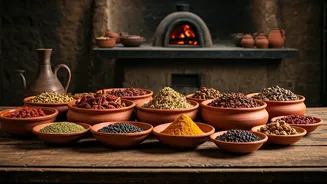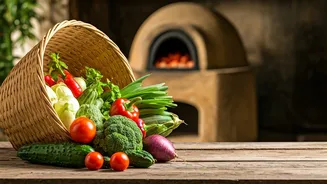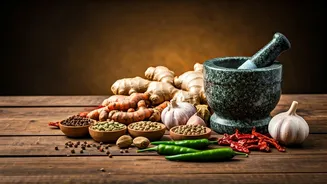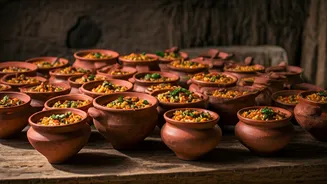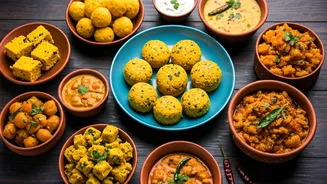Embrace Whole Foods
In the tribal kitchens of India, the emphasis is firmly placed on whole, unprocessed foods. This means a diet rich in grains, legumes, vegetables, and
fruits, often sourced locally and seasonally. The utilization of these ingredients is not just a culinary choice but a fundamental aspect of their way of life. The tribal communities have a deep understanding of the nutritional benefits of these foods, which are prepared using age-old methods to retain maximum nutrients. This contrasts starkly with the modern reliance on packaged and highly processed items that frequently lack essential vitamins and minerals. The focus on whole foods ensures a balanced intake of nutrients, promoting overall health and preventing lifestyle-related diseases.
Cooking with Seasonality
The tribal communities skillfully adhere to the rhythms of the seasons. Their culinary practices are closely linked to the availability of local produce. This means that menus are adjusted according to the seasons, with each period bringing forth a unique array of ingredients. During certain times of the year, leafy greens might be abundant, while in others, root vegetables or specific fruits take center stage. This seasonal approach is not just about variety; it ensures that people are consuming foods at their peak nutritional value, harvested when they are freshest. This practice also significantly reduces the need for artificial preservation methods and long-distance transportation, contributing to sustainability.
Minimal Processing Methods
Tribal kitchens prioritize cooking methods that preserve the integrity of the ingredients. The primary methods used are steaming, slow-cooking, and open-fire roasting, minimizing the use of processed ingredients and artificial additives. These time-honored techniques maintain the natural flavors and nutritional value of the food. Steaming, for example, is favored because it gently cooks food without leaching out vital nutrients. Slow-cooking, often over wood fires, allows flavors to meld beautifully and tenderizes tough cuts of meat or hardy vegetables. These cooking methods are not only healthier but also enhance the taste, showcasing the natural flavors of each ingredient. The emphasis is on simplicity, ensuring that the food retains its original characteristics and nutritive qualities.
Utilizing Diverse Spices
Indian tribal cuisine is known for its skillful and generous use of a wide range of spices. Not just for flavor enhancement, spices also play a significant role in health and digestion. Spices such as turmeric, ginger, and cardamom are not only used to add flavor but also possess anti-inflammatory and antioxidant properties. These spices are carefully incorporated into the cooking process, often combined to create complex flavor profiles while boosting the nutritional content of the dishes. The variety and combination of spices in tribal cooking reflect a deep understanding of their medicinal properties and a desire to create a holistic and balanced diet. These spices improve the palatability of the meals, encouraging people to eat more nutritious ingredients.
Preserving Food Traditions
Tribal kitchens carefully guard their time-honored culinary practices. Traditional methods of food preservation, such as sun-drying, pickling, and fermenting, are still in use. These techniques extend the shelf life of seasonal foods, ensuring a steady supply throughout the year. For instance, drying certain fruits and vegetables concentrates their nutrients, while pickling adds a layer of beneficial probiotics. Fermentation not only enhances the flavor of foods but also boosts the presence of beneficial bacteria, which aids digestion and strengthens the immune system. These methods exemplify the tribal communities' deep understanding of sustainability, ensuring that they can enjoy the bounty of the harvest year-round while reducing food waste.
Sustainable Cooking Practices
The tribal communities have a profound connection with the environment, which is mirrored in their cooking practices. They utilize local resources responsibly, reducing their environmental footprint. This includes the use of sustainable fuel sources, such as wood from renewable forests, and the avoidance of excessive waste. Cooking utensils are often crafted from natural materials like clay, bamboo, and wood, which are biodegradable and eco-friendly. Furthermore, the respect for nature encourages the tribal communities to use every part of an ingredient, promoting a zero-waste approach. This sustainable approach highlights the interconnectedness of food, culture, and the environment.
Embracing Communal Eating
Tribal kitchens are often at the heart of the community. Meals are frequently shared, fostering social bonds and reinforcing cultural identity. Preparing and eating food together creates a strong sense of togetherness, promoting values of sharing and cooperation. Communal eating is an integral part of their traditions, and it offers an opportunity to pass down culinary knowledge, stories, and customs from one generation to the next. The focus on shared meals encourages mindful eating, appreciating each bite and cultivating a deeper connection to food. This communal aspect demonstrates how food serves not only a physical but also a social and cultural purpose, strengthening the fabric of the community.


